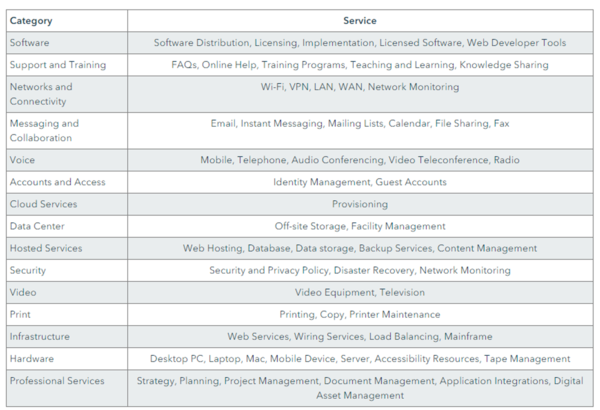Difference between revisions of "Service Catalog"
| Line 7: | Line 7: | ||
| − | [[File:Service Catalog.png| | + | [[File:Service Catalog.png|600px|Service Catalog]]<br /> |
Revision as of 14:23, 24 March 2021
An ITIL Service Catalog (or Service Catalogue) is the single source of accurate information on all IT services offered by an organization's IT department. ITIL defines a service catalog as a centralized database of accurate information about active IT service offerings, and a subset of the IT service provider's service portfolio. In simpler terms, it is the storefront from where end users (internal or external) request services and products from the IT service desk based on the information provided in the service catalog.[1]
Developing a Service Catalog[2]
Developing a service catalog may sound simple, but in order to encourage customer engagement and set proper expectations, it helps to consider the following tips to make it work:
- Identify the services your business needs in order to operate: Developing a service catalog is an exercise in good communication. Know your company and learn about its wants and needs. Business unit managers and other decision makers should work with both end users and stakeholders to determine what they need to perform their jobs. Differentiate between the services that your service desk and other IT teams currently provide and what may be missing. Are they essential and, more importantly, do they align with company goals?
- Define security and access permissions: Who will have access to the service catalog and specific services? Restricting access to the service catalog or specific services is important. You may want to allow end-users to request a keyboard or mouse, but limit items with a higher price tag, such as laptops or tablets, to management.
- Simplify the search process: Categorize services with your end user in mind. Simplify whenever possible and keep technical jargon to a minimum. For example, would a business user know to look under ‘infrastructure’ for backup services, or should ‘backup’ be front and center? Think about the intuitiveness of Amazon categorization. Confusion creates dissatisfaction, and dissatisfaction will defeat the purpose of your service catalog.
- Optimize the user experience: Make the user experience a friendly one with an easy-to-access, simple-to-navigate IT self-service portal that contains all of the services that they will need to do their job.
- Roll out in phases: Test a representative portion of your user pool with a small selection of services. Find out what works and what doesn’t. Solve the “glitches” and slowly increase the user base and offerings within your catalog.
- Invest in automation: Once you feel confident in the design of your service catalog and processes that support it, select a software product that best manages your company’s specific service needs – and automate delivery whenever possible.
The figure below illustrates where the Service Catalog fits in the Service Lifecycle.

source: ITIL News
See Also
ITIL (Information Technology Infrastructure Library)
ITIL Availability Management
ITIL Continual Service Improvement (CSI)
ITIL Event Management
ITIL Facilities Management
ITIL Problem Management
ITIL Service Delivery
ITIL Service Design
ITIL Service Lifecycle
ITIL Service Strategy
ITIL Service Operation
ITIL Service Value Chain (SVC)
ITIL Service Value System (SVS)
Service Portfolio Management
Service Portfolio
Service Catalog
IT Governance
IT Infrastructure
IT Operations (Information Technology Operations)
Control Objectives for Information and Related Technology (COBIT)
Balanced Scorecard
Enterprise Risk Management (ERM)
Risk Management
IT Strategy
Business Strategy
Corporate Governance
Corporate Strategy
Enterprise Architecture
COSO Internal Control- Integrated Framework
Compliance
References
- ↑ Definition - What Does Service Catalog Mean in ITIL? Manage Enine
- ↑ How to Develop a Service Catalog Cherwell
See Also
ITIL (Information Technology Infrastructure Library)
ITIL Availability Management
ITIL Continual Service Improvement (CSI)
ITIL Event Management
ITIL Facilities Management
ITIL Problem Management
ITIL Service Delivery
ITIL Service Design
ITIL Service Lifecycle
ITIL Service Strategy
ITIL Service Operation
ITIL Service Value Chain (SVC)
ITIL Service Value System (SVS)
Service Portfolio Management
Service Portfolio
Service Catalog Management
IT Governance
IT Infrastructure
IT Operations (Information Technology Operations)
Control Objectives for Information and Related Technology (COBIT)
Balanced Scorecard
Enterprise Risk Management (ERM)
Risk Management
IT Strategy
Business Strategy
Corporate Governance
Corporate Strategy
Enterprise Architecture
COSO Internal Control- Integrated Framework
Compliance

